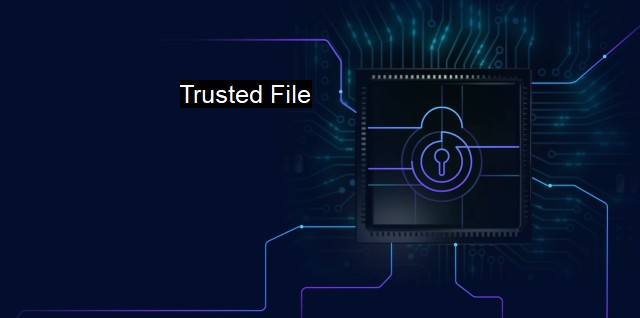What is Trusted File?
The Importance of Trusted Files in Cybersecurity: Understanding this Vital Term for Antivirus Programs and Protection Against Cybercrime
A "Trusted File" is a term that denotes a particular file or group of files regarded as safe or harmless by cyber defense software or programs. a Trusted File doesn't trigger any processes related to threat detection, manipulation, or eradication, as performed by antivirus software. defining a file as "trusted" does not automatically mean they are genuinely safe. It simply means that the protection system accepts them as safe due to various parameters, and much rests on these parameters and how accurate or trustworthy this trust context is.In an effective cybersecurity eco-system and for a fully functional defensive line, 'trust' carries a significant amount of weight. Trust fundamentally means that the file or entity has been classified as non-threatening by defending software, thus eliminating the immediate need for extensive scrutiny. Under the normal circumstances and manual checks, files are sent to Quarantine or discarded when detected as harmful. But for trusted files, the software assumes these are safe and does not treat them as potential threats.
The primary purpose of designating a file as a safe or Trusted File is efficiency. With numerous files streaming into a device and network, it is impossible to scan and scrutinize each one of them. Folders that are known to only carry out particular benign functions could take up valuable time and computing power if they had to be checked each time they interact with the network. Tagging them trusted saves valuable resources.
The designation of Trusted Files is based on several factors. One is the reputation of an item in the cloud as represented by a hash – a digital fingerprint derived from properties like its name, size, and publisher. Antivirus software processes these parameters and ensures no malicious code has tampered with the file. Trusted files or vendors are those that show no previous intention to distribute malware or engage in malicious activities, or whose software tool have not had any harmful vulnerability exposed or exploited.
Even though there is an obvious advantage to tagging non-threatening files as "trusted," it carries a downside as well. Cyber attackers have discovered ways to exploit this trust and plant malware or perform malicious actions undetected by disguising it as a Trusted File. This occurs when the antivirus software identifies a file without rigorous inspection because it matches a safe fingerprint in its database.
Zero-day attacks, polymorphic viruses, and advanced persistent threats (APTs), as well as other sophisticated cyber threats, can successfully worm their way into systems under the guise of these Trusted Files. This constitutes misappropriation of trust and conceals malicious intent, making cyber-attacks difficult to perceive, much less prevent or mitigate.
Also, outdated security definitions or critical vulnerabilities in antivirus software can result in untrustworthy files getting the 'trusted' status. If incorrect categories are assigned, systems risk being exposed to malware, thus dismissing the benefits of establishing extensive defenses.
As cybersecurity threats evolve, the concept of Trust is also changing to embrace Radical Trust or Zero Trust Models. These models do not blindly assign trust to files and rather operate on the premise that even if a file was secure earlier, it doesn't necessarily mean it's secure now. Wi-Fi networks and Bluetooth connections have reinforced this shift, making the reliance entirely on Trusted Files outdated.
a Trusted File within the framework of cybersecurity and antivirus refers to a file considered secure based on various factors. Yet, it must be remembered that trusting files comes with drawbacks. Even with elaborate security measures, there will always be a decision-making process associated with classifying files as trusted or untrusted. As cybersecurity evolves, so does our relationship with trust, requiring us to be vigilant and proactive in our cybersecurity strategies.

Trusted File FAQs
What is a trusted file in the context of cybersecurity and antivirus?
A trusted file is a file that has been verified as safe and secure by the antivirus software. The software has determined that the file does not contain malicious code or other threats to the system.How does antivirus software determine if a file is trusted?
Antivirus software uses a variety of techniques to determine if a file is trusted. These may include examining the file's digital signature, checking it against a database of known malicious files, and analyzing its behavior when opened.Can trusted files still pose a threat to my system?
While trusted files are generally considered safe, there is always a risk that they could be compromised by attackers. For example, a trusted file could contain a vulnerability that can be exploited by an attacker. However, the risk is much lower than for files that are not trusted.How can I ensure that a file is trusted before opening it?
Before opening a file, you can check its digital signature to see if it is from a trusted source. You can also scan the file with antivirus software to check for any threats. It is important to keep your antivirus software up to date to ensure that it can accurately detect and prevent new threats.| | A | | | B | | | C | | | D | | | E | | | F | | | G | | | H | | | I | | | J | | | K | | | L | | | M | |
| | N | | | O | | | P | | | Q | | | R | | | S | | | T | | | U | | | V | | | W | | | X | | | Y | | | Z | |
| | 1 | | | 2 | | | 3 | | | 4 | | | 7 | | | 8 | | |||||||